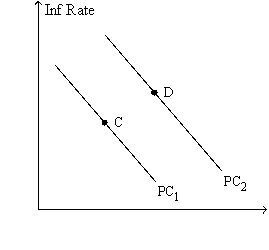A) the outcome of a favorable supply shock.
B) falling inflation.
C) stagflation.
D) All of the above are correct.
F) A) and C)
Correct Answer

verified
Correct Answer
verified
Multiple Choice
The short-run relationship between inflation and unemployment is often called
A) the Classical Dichotomy.
B) Money Neutrality.
C) the Phillips curve.
D) None of the above is correct.
F) C) and D)
Correct Answer

verified
Correct Answer
verified
True/False
If prices and wages adjusted rapidly and producers could quickly distinguish the difference between a change in the price level and a change in the relative price of their products, then an increase in the money supply growth rate would have at most a very short-lived affect on unemployment.
B) False
Correct Answer

verified
Correct Answer
verified
Multiple Choice
Which of the following is an example of an adverse supply shock?
A) a decrease in the money supply
B) a tax cut
C) a worldwide drought
D) decreased government spending
F) A) and B)
Correct Answer

verified
Correct Answer
verified
Multiple Choice
If people anticipate higher inflation, but inflation remains the same then
A) the short-run Phillips curve would shift right and unemployment would rise.
B) the short-run Phillips curve would shift right and unemployment would fall.
C) the short-run Phillips curve would shift left and unemployment would rise.
D) the short-run Phillips curve would shift left and unemployment would fall.
F) A) and C)
Correct Answer

verified
Correct Answer
verified
Multiple Choice
In the long run, if there is an increase in the money supply growth rate, which of the following curves shifts right?
A) the short-run and the long run Phillips curves
B) the short-run but not the long run Phillips curve
C) the long-run but not the short-run Phillips curve
D) neither the short-run nor the long-run Phillips curves
F) A) and D)
Correct Answer

verified
Correct Answer
verified
True/False
U.S. monetary policy in the early 1980s reduced the inflation rate by more than half.
B) False
Correct Answer

verified
Correct Answer
verified
Multiple Choice
In the long run, an increase in the money supply
A) leaves prices and unemployment unchanged.
B) raises prices and unemployment.
C) raises prices and leaves unemployment unchanged.
D) leaves prices unchanged and reduces unemployment.
F) B) and C)
Correct Answer

verified
Correct Answer
verified
Multiple Choice
If unemployment is below its natural rate, what happens to move the economy to long-run equilibrium?
A) Inflation expectations rise which shifts the short-run Phillips curve to the right.
B) Inflation expectations rise which shifts the short-run Phillips curve to the left.
C) Inflation expectations fall which shifts the short-run Phillips curve to the right.
D) Inflation expectations fall which shifts the short-run Phillips curve to the left.
F) A) and B)
Correct Answer

verified
Correct Answer
verified
Multiple Choice
According to the Phillips curve, unemployment and inflation are positively related in
A) the short run and in the long run.
B) the short run, but not in the long run.
C) the long run, but not in the short run.
D) neither the long run nor the short run.
F) All of the above
Correct Answer

verified
Correct Answer
verified
Multiple Choice
Phillips found a negative relation between
A) output and unemployment.
B) output and employment.
C) wage inflation and unemployment.
D) None of the above is correct.
F) A) and C)
Correct Answer

verified
Correct Answer
verified
Multiple Choice
Figure 17-8. The left-hand graph shows a short-run aggregate-supply (SRAS) curve and two aggregate-demand (AD) curves. On the right-hand diagram, "Inf Rate" means "Inflation Rate."

 -Refer to Figure 17-8. The shift of the aggregate-supply curve from AS1 to AS2
-Refer to Figure 17-8. The shift of the aggregate-supply curve from AS1 to AS2
A) results in a more favorable trade-off between inflation and unemployment.
B) results in a more favorable trade-off between inflation and the growth rate of real GDP.
C) represents an adverse shock to aggregate supply.
D) represents a favorable shock to aggregate supply.
F) A) and C)
Correct Answer

verified
Correct Answer
verified
Multiple Choice
Which of the following would cause the price level to rise and output to fall in the short run?
A) an increase in the money supply
B) a decrease in the money supply
C) an adverse supply shock
D) a favorable supply shock
F) B) and C)
Correct Answer

verified
Correct Answer
verified
Multiple Choice
If the government reduced the minimum wage and pursued expansionary monetary policy, then in the long run
A) both the unemployment rate and the inflation rate would be higher.
B) both the unemployment rate and the inflation rate would be lower.
C) the unemployment rate would be higher and the inflation rate would be lower.
D) the unemployment rate would be lower and the inflation rate would be higher.
F) B) and D)
Correct Answer

verified
Correct Answer
verified
Multiple Choice
In 2001, Congress and President Bush instituted tax cuts. According to the short-run Phillips curve, in the short run this change should have
A) reduced inflation and unemployment.
B) raised inflation and unemployment.
C) reduce inflation and raised unemployment.
D) raised inflation and reduced unemployment.
F) None of the above
Correct Answer

verified
Correct Answer
verified
Multiple Choice
Which of the following leads to a lower level of unemployment in the long run?
A) both an increase in the size of the money supply and an increase in the money supply growth rate
B) an increase in the size of the money supply but not an increase in the money supply growth rate
C) an increase in the money supply growth rate, but not an increase in the size of the money supply
D) neither an increase in the size of the money supply nor an increase in the money supply growth rate
F) A) and D)
Correct Answer

verified
Correct Answer
verified
Multiple Choice
Sticky wages leads to a positive relationship between the actual price level and the quantity of output supplied in
A) both the short and long run.
B) the short run, but not the long run.
C) the long run, but not the short run.
D) neither the short nor the long run.
F) A) and D)
Correct Answer

verified
Correct Answer
verified
Multiple Choice
Other things the same, if the central bank decreases the rate at which it increases the money supply, then in the long run
A) the short-run Phillips curve shifts right.
B) the short-run Phillips curve shifts left.
C) the long-run Phillips curve shifts right.
D) the long-run Phillips curve shifts left.
F) A) and B)
Correct Answer

verified
Correct Answer
verified
Multiple Choice
Figure 17-1. The left-hand graph shows a short-run aggregate-supply (SRAS) curve and two aggregate-demand (AD) curves. On the right-hand diagram, U represents the unemployment rate.
 -Refer to Figure 17-1. Assuming the price level in the previous year was 100, point F on the right-hand graph corresponds to
-Refer to Figure 17-1. Assuming the price level in the previous year was 100, point F on the right-hand graph corresponds to
A) point A on the left-hand graph.
B) point B on the left-hand graph.
C) point C on the left-hand graph.
D) point D on the left-hand graph.
F) B) and C)
Correct Answer

verified
Correct Answer
verified
Multiple Choice
The monetary-policy framework called inflation targeting is used explicitly by
A) no major country.
B) most major countries except the United States and Japan.
C) the United States, but it is not used by other major countries.
D) most major countries, including the United States and Japan.
F) B) and D)
Correct Answer

verified
Correct Answer
verified
Showing 81 - 100 of 367
Related Exams